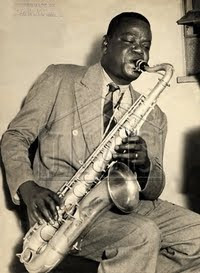Dino Sete Cordas
 Horondino José da Silva (1918-2006), known as Dino Sete Cordas, was a famous musician and quite an institution on the popular Brazilian music scene. Dino Sete Cordas was the developer of the seven-string guitar style. In more than 70 years of active and uninterrupted professional activity, he accompanied uncountable important artists from several different generations and styles, arranging and orchestrating for recordings as well.
Horondino José da Silva (1918-2006), known as Dino Sete Cordas, was a famous musician and quite an institution on the popular Brazilian music scene. Dino Sete Cordas was the developer of the seven-string guitar style. In more than 70 years of active and uninterrupted professional activity, he accompanied uncountable important artists from several different generations and styles, arranging and orchestrating for recordings as well. Alvaro Neder writes a career profile in AMG, quoted below:
"Son of an amateur violonista (Brazilian acoustic guitarist) and having also two brothers influenced by music (Lino, cavaquinho, and Jorginho, a percussionist who later worked with the renowned Época de Ouro), Cordas began to play in seresta groups at 14. Cordas became a professional in 1935, accompanying the singer Augusto Calheiros, who used to perform in circuses. At that time Cordas was already developing his style, which is based on melodic and quick basslines (baixarias). In 1937, Ney Orestes, then violonista of the famous Regional de Benedito Lacerda, became ill, and Cordas subbed for him. Upon Orestes' death, Cordas became permanent in the group. With the substitution of the regional's other violonista Carlos Lentine by Meira (Jaime Florence), the duo Cordas-Meira, one of the most fruitful, famous, and long-lived of Brazilian popular music, was formed. The Regional de Benedito Lacerda accompanied many stars of the time, such as Carmen Miranda, Francisco Alves, Silvio Caldas, and Orlando Silva, among others. In 1950, the Regional de Benedito Lacerda was transformed into the Regional do Canhoto, and Cordas continued in the new group. After Tute retired, he added a seventh string (C) to his violão just like the pioneer did, enhancing the expressive power and stretching the possibilities of his baixarias. Meanwhile, the Regional do Canhoto continued in its successful career as accompanist for famous performers, in live performances and in radio and recordings.
The end of the '50s, with the inception of bossa nova, radically changed the taste of the masses concerning music. If choro performers could easily adapt their playing to suit sambas, sambas-canção, bolero, and other styles/genres, bossa nova was a completely different thing, and the later trend of Jovem Guarda (a teenybop style heavily influenced by British rock) would shut the doors of commercial music for remnants of the choro genre. Cordas adopted an electric guitar and joined Paulo Barcelos' group, specializing in dance parties and balls. Around 1965, the market began to welcome recordings of escolas de samba (samba schools). The sete cordas (seven-string violão) was again required. In 1965 and 1967, Cordas participated in the live recordings of the two LP's of the historic show Rosa de Ouro, by Hermínio Bello de Carvalho, with singers Clementina de Jesus and Aracy Cortes. At that time he was also playing with Jacó do Bandolim's Conjunto Época de Ouro. In 1970, the samba and the choro came up again, and Cordas returned to his busy schedule of recordings and live performances accompanying singers like Beth Carvalho, Gilberto Gil, Jards Macalé, Vinícius de Moraes, and Toquinho, among many others. In 1974 he arranged and conducted two important albums, the first solo one by Cartola, and A Música de Donga, in which the works of the important composer were recorded by Elizeth Cardoso, Paulo Tapajós and others, both released by the label specializing in musical history documentation Marcus Pereira. In 1976 Cordas orchestrated the second album by Cartola. In 1991, he recorded an important album with the late phenomenon Raphael Rabelo. Cordas continued to play samba and choro in several formations and venues."
I found a video homage to Dino Sete Cordas on YouTube. Enjoy!



2 Comments:
Thank you for this great contribution Joergen. I liker this music.
And ............... thanks for the nice film fragment inserted ( ! ) into the trext files !!
Hans
muy bueno, felicitaciones por el contenido del blog.
Post a Comment
<< Home